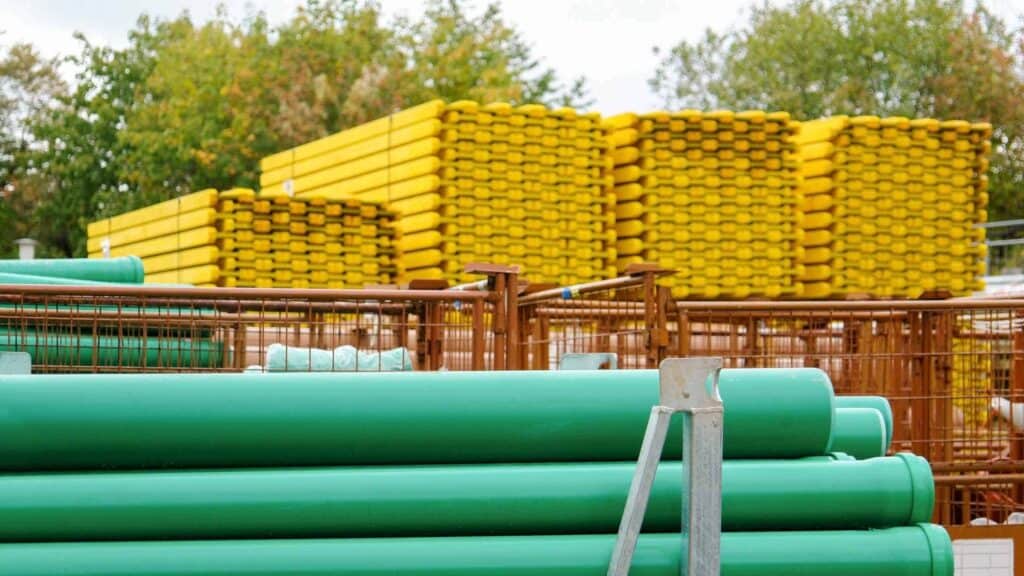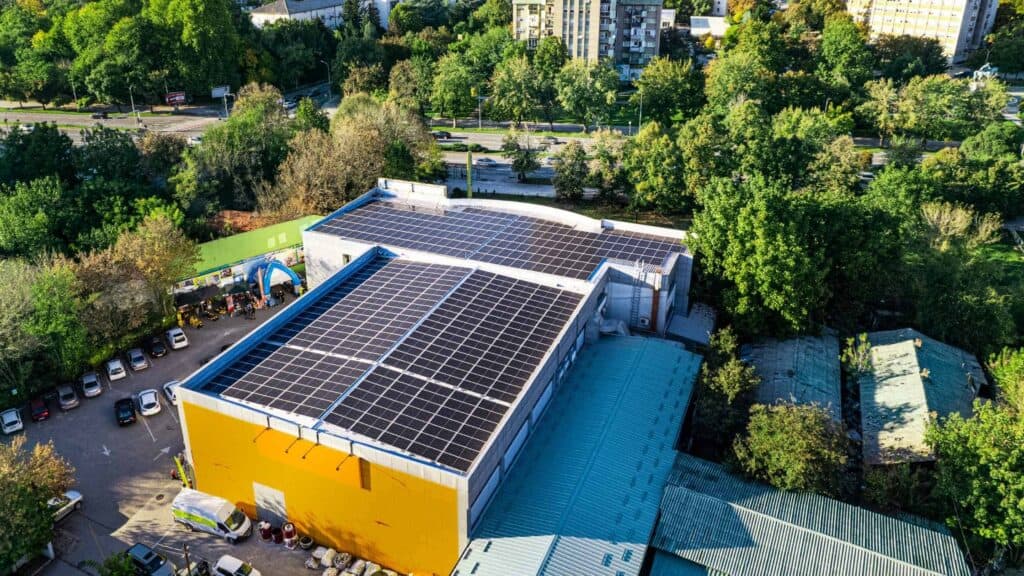We’ll explore the most sustainable building materials for homes that you can use in your next project. You will certainly respect the environment and bring even more value to your construction!
Eco-friendly building materials are the way of the future. After all, the demand for works that embrace the notion of sustainable architecture has expanded to the point where it is difficult not to incorporate these new technologies into the project scope.
Sustainable materials like bioconcrete, bioplastic, EcoGranite, solar panels, adobe brick, and recycled blankets are becoming increasingly popular in the civil construction sector. Follow the tips in this article if you are a professional looking to incorporate more sustainable techniques into your next initiatives.
Most Sustainable Building Materials For Homes
The adoption of more sustainable materials and methods is a significant differentiator in the civil construction sector. After all, in recent years, there has been an increase in environmental concern. Yet, what exactly are sustainable materials? To clear up any confusion, we have compiled a list of 23 sustainable materials that can be utilized in civil construction and architecture.
Examples Of Sustainable Building Materials

1. Bioconcrete
Bioconcrete is created by mixing regular concrete with Bacillus pseudofirmus bacteria colonies. These bacteria, which can live for almost 200 years, are found in harsh environments such as active volcano craters and frozen lakes in Russia. Bioconcrete can regenerate itself through the feeding and digestion of these bacteria, increasing its durability and reducing the need for future labor and maintenance costs.
2. Ecological Inks
Ecological paints, often known as sustainable paints, are manufactured from natural or non-harmful components. As a result, the majority of these eco-friendly paints are based on the presence of water, clay, corn starch, and glue. Color can be obtained by the use of flowers and fruits.
3. Plaster Brick – Is Brick A Sustainable Building Material?
Plaster brick is a sort of coating created by shaping raw plaster into grooved shapes. The cladding is ideal for dry conditions on the property. In addition to bringing beauty to the space, it is more accessible in terms of material and labor. The trash creation is small, so the work will have less rubble to be disposed of.
4. Ecological Brick
When the work to be done embraces the ideals of sustainable architecture, ecological brick is one of the most commonly employed materials. For those who are unfamiliar, an ecological brick is a type of brick that is created by combining water with soil or other natural or recyclable waste. It does not go through a burning process, reducing the emission of damaging gases into the atmosphere.
5. Reclaimed Wood – Energy-Efficient Windows And Doors
Reclaimed wood is wood that has been salvaged from old structures such as houses, sheds, or warehouses. This high-value material is frequently utilized in the manufacture of furniture, doors, windows, panels, ceiling linings, baseboards, and other coverings.
6. Reforested Wood
Reforested wood is the type of wood that has already been planted with the intention of being harvested later for use. Trees native to the region are not felled in this manner, but trees selected in advance, for this reason, are planted and removed.
As a result, increasing the use of reforestation wood aids in environmental preservation. These sustainable materials can be utilized in projects to make furniture, floors, panels, and other elements and finishes.
7. Corks – Sustainable Insulation Materials
Cork is also on our list of environmentally friendly materials. It is physically removed from the bark of cork oaks, a tree in the oak family that regenerates itself without causing harm to the tree. It is lightweight and has a high insulating capacity (thermal and acoustic insulation). Cork can be used as a wall covering or in the production of furniture, such as headboards, coffee tables, and shelves.
8. Ecological Tile
We couldn’t have a list of sustainable materials without including ecological tile. It is manufactured from recycled materials such as long-life packaging, PET bottles, or natural fibers like wood, sisal, and coconut. The ecological tile in the project can be utilized on the roofs of residences, sheds, building sites, or sheds.
9. Green Roofs – Sustainable Roofing Materials
Green roofs are taking up more and more space in construction. Its basic structure consists of a drainage blanket, a substrate layer, and a vegetative layer (grasses and small bushes). Nonetheless, it is critical to analyze the roof to ensure that it can hold the weight of this construction.
In large urban areas, green roofs have shown to be an invaluable ally in combating the infamous “heat islands” generated by the buildup of real estate and the absence of greenery.
10. White Roof
The white roof represents beauty, sophistication, and energy efficiency. Studies have shown that utilizing white tile or painting the roof white can reduce the temperature in the property’s environs by 40% to 70% while also reducing UV radiation by up to 96%. It’s no surprise that white tile and a white-painted roof are popular in places like Greece.
11. Solar Panel

Solar panels installed on the roof transform sunlight into electrical energy. This system is made up of numerous components, including a solar panel. The installation of this technology ensures the properties’ energy independence, resulting in less environmental impact and electricity bill savings.
12. LED Lamps
Unlike incandescent, halogen, and fluorescent lights, which use filaments and gases to generate light, LED lamps generate energy using a semiconductor chip. LED lamps not only use less energy but also last 15 to 25 times longer than incandescent lamps and do not produce UV radiation.
13. Bamboo
In addition to being included in this list of sustainable materials, bamboo is also included in the list of biodegradable materials for civil construction. Because of its lightness and excellent tensile strength, bamboo is widely employed in construction and decorating. Furthermore, it is regarded as a renewable resource due to its rapid growth when compared to other tree species.
14. Bioplastic
As the name implies, bioplastic is a substance manufactured from biodegradable basic ingredients. It decomposes significantly faster in the environment than synthetic plastics due to its unique production. Bioplastic has been utilized in civil construction to make items such as floors, baseboards, room walls, and other coatings.
15. Discharge With Double Trigger
A great way to reduce water usage in the bathroom is to replace your standard flush with one having a double trigger. The user has two options with this mechanism: a partial flush of 3 liters (excellent for liquid waste) or a total flush of 6 liters (ideal for solid waste).
16. EcoGranite
EcoGranite was developed in Japan as an option to reduce the effects of earthquakes. It is a sustainable coating manufactured from waste generated during the extraction of granite and marble from deposits. Ecogranite can be used in a variety of projects, including property facades, countertops, grill coatings, and more.
17. Linoleum – Choosing Sustainable Flooring Materials
Linoleum flooring has been in use for more than 150 years. Despite its age, linoleum has evolved over time and used technology to become even more durable, and resistant. Linseed oil, natural resins, cork dust (or sawdust in some circumstances), limestone dust, jute cloth, and colors are common ingredients.
18. Water-Soluble Plastic
A water-soluble plastic is one that dissolves easily when exposed to water. Except for water, they are made of polyvinyl alcohol (PVOH) and have good barrier and resistance properties.
19. Recycled Blanket – Recycling And Repurposing In Sustainable Building
As the name implies, recycled blankets are constructed from recycled materials such as PET (industrial waste and post-consumer PET bottles). The use of recycled blankets keeps the room cool and minimizes the intensity of noise in the interiors of houses and apartments.
20. Inverter Air Conditioning
Inverter air conditioning is a decorating trend that has taken over numerous projects that prioritize energy efficiency and sustainability. This is due to the fact that inverter technology regulates the energy flow of the system, adjusting the speed of the compressor when it detects that the environment requires less cooling or heating.
21. Clay Mortar
Clay mortar is a natural and environmentally friendly mortar that performs similarly to cement mortar. Among the main perceived benefits, clay mortar provides higher thermoacoustic insulation and prevents humidity from rising inside the surrounding area.
22. Adobe Brick
If you’re interested in bioconstruction, you’ve probably heard about Adobe buildings. Adobe brick is one of the most commonly used elements in the construction of these structures. The adobe brick is formed from a mixture of raw dirt, straw, and water, which is then molded and sun-dried.
23. Shipping Containers
The utilization of shipping containers to construct homes and businesses is gaining popularity all around the world. In addition to insuring the reuse of these cargo vaults, container construction is more accessible and, in general, 2 to 3 times faster than conventional construction.
Green Building Materials
Using sustainable construction materials is a crucial step in creating a more sustainable and environmentally-friendly future. With a wide range of sustainable options available, it’s never been easier to incorporate eco-friendly practices into your construction projects.
By using these top 23 alternative building materials, you can help to reduce your impact on the environment while creating beautiful and functional spaces that will stand the test of time.
